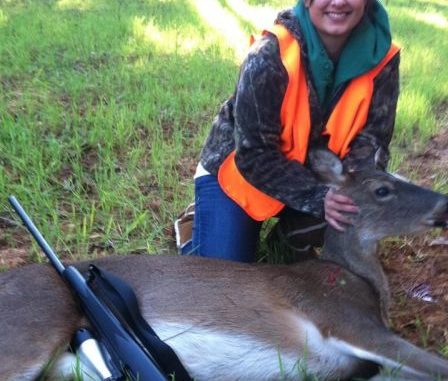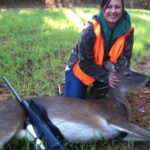
Time to prep for upcoming hunting season
The work that has been done the past two years will determine one’s hunting success in the upcoming turkey season.
It is hard to believe that a year has already gone by and it is time to talk turkey next month. Hopefully you have been paying attention to the turkeys during the deer season and have already lined up your hunts for the season.
Turkeys are creatures of habit, and the birds you were seeing during the deer season will be the birds you will be hunting in March.
Keep in mind that, as the breeding season approaches, the turkey flocks will be breaking up; hens will be moving to the fields and selecting places for nesting, while the toms will be following them — gobbling and strutting.
The patches you planted with winter grass and clover should be quite attractive for them; hens need the green material for egg production.
I always like to break up the ground in the sites I will be planting in the spring and summer during February or early March. This will give the birds some additional areas for foraging; birds like to scratch the soil and dig up critters and seeds. Don’t let the rye grass get too tall because it makes it difficult for turkeys and for you to see them when hunting. A little clipping might help you have a successful season.
The adult toms you will be hunting were hatched in 2011 or prior. Jakes will almost be a year old for the 2013 season. The jake kill in 2012 reduced the adult toms available for harvest in 2013. The annual harvest of jakes across Louisiana is low; most hunters will opt to pass up a jake and allow it to grow older.
Last year I wrote about a band of brothers that I watched during the 2011 deer season. They pretty much hung around all season but disappeared when the 2012 turkey season opened. There were a couple of adult toms that were seen and photographed on the cameras during the deer season, also, and I was blessed to harvest one.
I sat in the turkey blind one day in late November during the 2012 deer season and, low and behold, the band of brothers walked by me that morning (about 10 feet from the blind). I was pleased to see that the toms are still around. I wonder how much they will like each other when the gobbling starts?
Two of them had good beards and it looked like all had 1-inch spurs.
What is really exciting is that there were also two more adult toms photographed during this past deer season. It will be interesting to see who the boss gobbler is this spring at Camp David.
The other small tract of land I hunt is also loaded with turkeys this year, including several toms 3 years old or older. There is one old boss tom that eluded me several times last season and is at the top of the hit list for this season.
Turkey-hunting success is all about having gobblers to hunt. There’s nothing worse than going out opening day to hunt turkeys and never hearing a gobble.
Turkeys respond well to habitat management, and if you have been doing this management work you should have success.
Turkeys like a diverse habitat of forests and fields.
Management work includes forest work that enhances the hardwood component, both the hard mast and soft mast species. A mixed pine/hardwood forest that is managed with controlled burns benefits the birds. Open areas for foraging and raising poults is very desirable and needed for the young birds to survive to adulthood.
The birds respond well to food plot management, and this work should involve both spring and summer plantings. The edges of these openings provide sites for nesting, as does timber cutting.
Turkeys respond to clear-cutting, but do not do it on a large scale.
It is critical that the young turkeys have good foraging sites. If the ground cover is too thickly, the newly hatched turkeys are not able to move through the vegetation and find insects. Prior to the birds hatching I like to do some clipping and even light disking to provide forage habitat for the small turkeys.
The first few weeks are critical; until the young birds can fly and roost off the ground, they are subject to predators. Provide escape cover for the birds while they are feeding so they can hide from hawks and owls.
Of course, much of this management work also will benefit other wildlife species.
As mentioned earlier, turkeys benefit from winter plantings of grass and clover. Spring plantings could include millet, sunflowers and sorghum. Chufas are an excellent turkey food; this sedge produces tubers that turkeys scratch up and eat. The problem with chufas is that it also is a preferred food item of hogs, and if you have hogs — and these days most people have them — they will destroy your chufa patch. Hogs will also eat the other grain crops, so hog control should be part of your management work.
Some of the other legumes, such as partridge pea and Illinois bundle flower, might be an alternative crop that hogs will not mess with too much. I like to leave strips of my spring planting mixes standing in the field during winter, and then will clip them prior to the turkey season.
I really believe that the success we are having with turkeys is directly related to the management work we are doing. If you walk away from your habitat after the deer season and do nothing until it is time for the next deer season, you aren’t doing anything for the turkeys.
On the deer front, there has been concern by LDWF during the past few years about the low deer kill. Is our state population declining, do we need to reduce the season, cut either-sex days?
There are a lot of questions that the harvest data is just not answering.
No doubt, the deer kill will again be down this year. Hunters in the swamp areas hit hard by Hurricane Isaac had their seasons reduced, so the harvest will certainly be down from these parishes.
Area 2 seems to have had a good season and hopefully will have decent harvest numbers. My favorite niece, Elizabeth Glass, killed her first deer this past season (way to go Liz!) in Webster Parish.
I was looking forward to a good season in Areas 1 and 6, but the weather has been the pits. I am writing this in mid-December, just before Christmas, and on Dec. 15 in Baton Rouge I saw as many people wearing shorts and T-shirts, and cutting grass as I did during a Saturday in June. It is just not right to be cutting grass in December, but the grass does not know it is winter.
Trees are beginning to bud out and flower. With weather like this, deer movement goes to zero, as does the deer harvest, so if the harvest is down in our parishes I am blaming Mother Nature. Hopefully January will have brought us some good winter days.
It is also time to start measuring deer racks. If you were successful and harvested a nice buck this past season, you should take the time to have it scored. Enter the Louisiana Sportsman Big Buck Contest to be held in conjunction with the Louisiana Sportsman Show scheduled fro march 14-17 in Gonzales or the Bowie Outfitters Big Buck Contest and get an official score.
The big prizes at each contest are given away by a simple drawing of all who enter, and you can’t win if you don’t enter. I still think the new state record typical buck will come out of Avoyelles Parish — and if Mother Nature would bless us with a very cold January, this could be the year.




